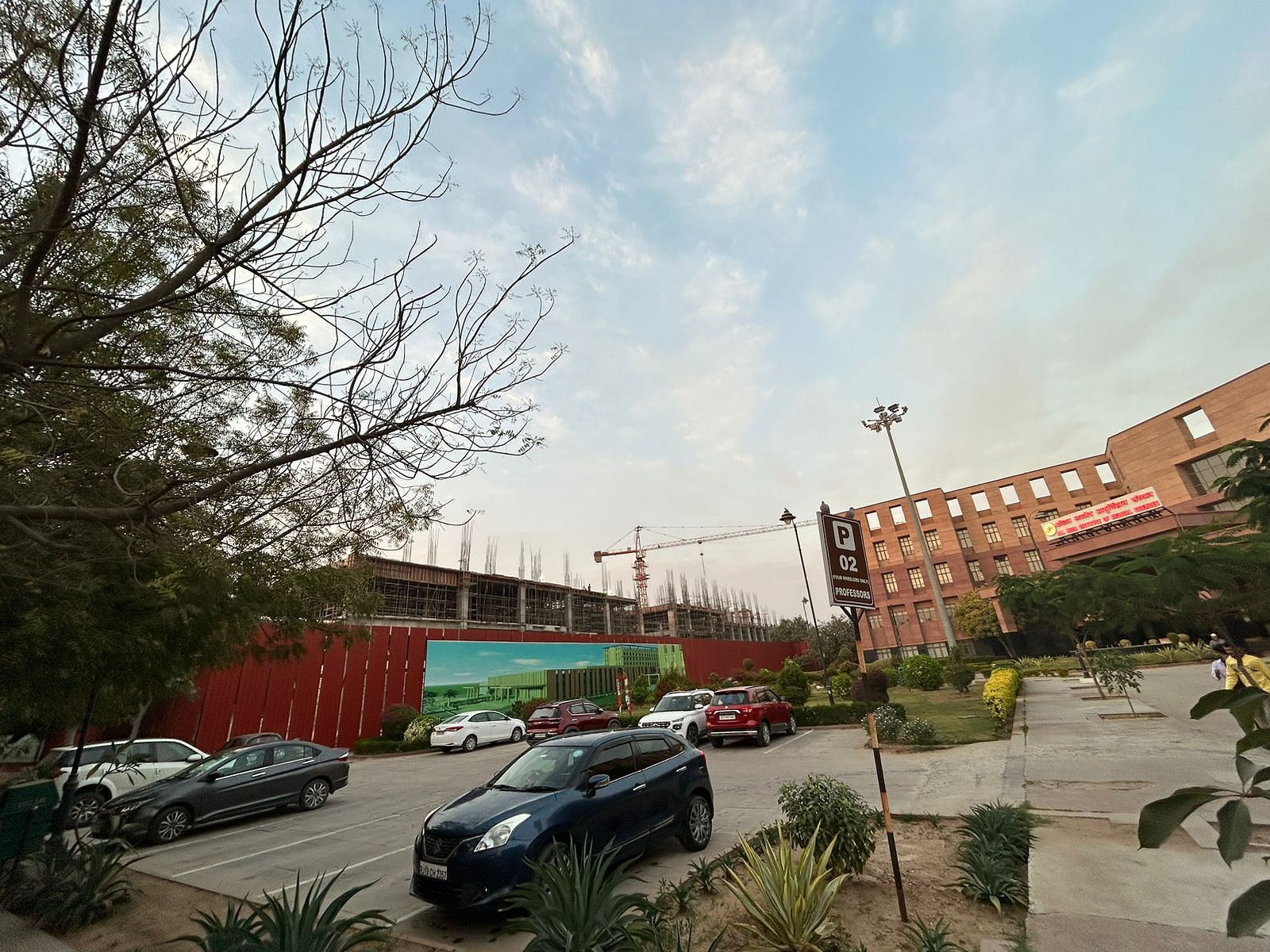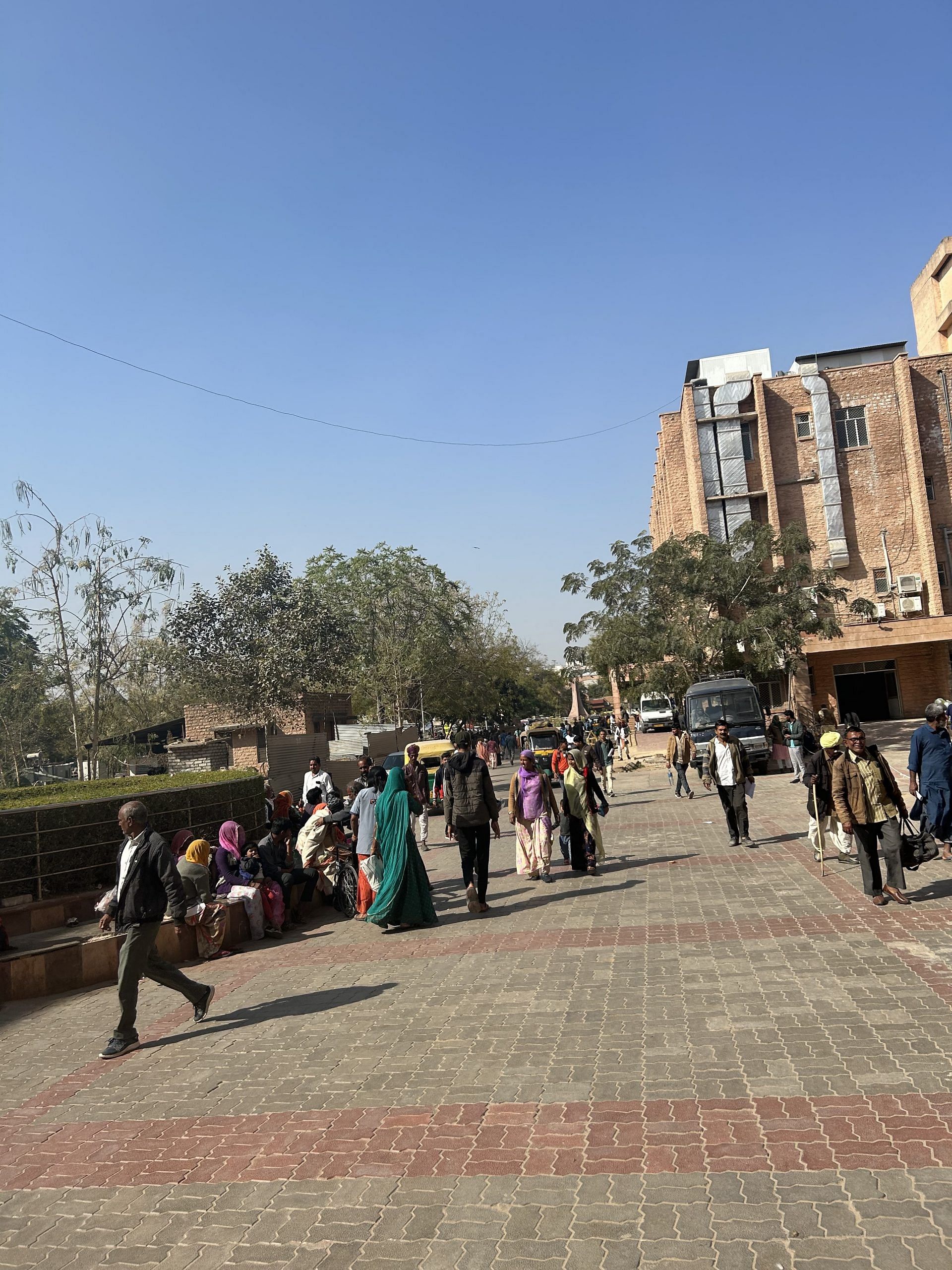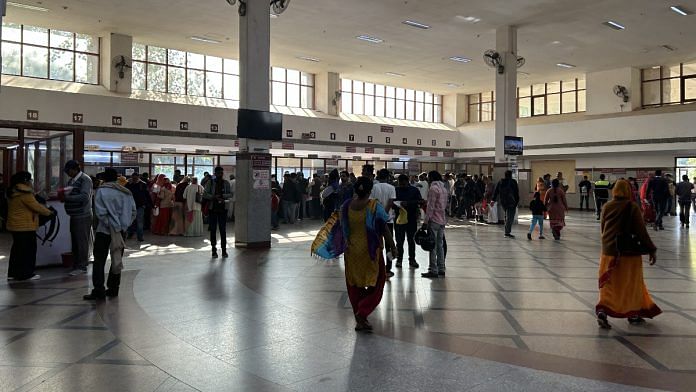Jodhpur: Soon after N. R. Bishnoi took over as deputy director of AIIMS Jodhpur in 2015, a complaint letter landed on his table. It said the doctors at the new hospital were spending too long with the patients — sometimes even up to 15 minutes.
This was an anomaly for people who were used to doctors spending less than two minutes to write prescriptions before sending them away. The complaint marked an important milestone for AIIMS Jodhpur. They had changed the healthcare conversation in the region in less than ten years after opening their OPD to patients.
“The doctors talk to you nicely,” says 40-year-old Kamala Devi from Ajmer, as she waited for her husband to return from the pharmacy. Their empathy and patience made all the difference when she was wheeled into the intimidating MRI machine for a brain scan.
“My forehead vein got blocked. But I’ve got some relief from the pain,” says Kamala.
The setting up of AIIMS in Jodhpur has stemmed the desperate flight of patients from the desert districts to private hospitals and nursing homes that line highways in Gujarat. Its clean, gleaming air-conditioned rooms and hallways with doctors who are “nice”, are upending the popular perception about government hospitals and bringing affordable, quality healthcare for the poor.
“This is the only one of the first six AIIMS which is 370 kilometres away from the state capital,” says Dr. Sanjeev Mishra, the first director of the institute. He says that despite having reduced connectivity and access to resources, AIIMS Jodhpur has become a success.
As dean (academics) and head of paediatrics, Professor Dr. Kuldeep Singh doesn’t want to drop the ball. It’s imperative that AIIMS Jodhpur remains the best among its regional siblings.
“We are at the 16th position in overall NIRF [National Institutional Ranking Framework] ranking and second after AIIMS Delhi,” says Singh with pride.
AIIMS Delhi ranks highest in this list of the top medical colleges, and the one in Jodhpur is the only other AIIMS that makes it to the top 20.
But having raised people’s expectations, it is now struggling to catch up. It needs more beds, more equipment and most importantly, more doctors.
The second part of ThePrint’s series on regional AIIMS hospitals explores how the Jodhpur AIIMS managed to win people’s trust and build its reputation among the medical fraternity.
Also Read: One woman’s fight to pull AIIMS-Rishikesh out of a decade of raids, scams, lies
Inspiration, competition and trust
For decades, the rich and the poor in western Rajasthan flocked to Ahmedabad and Mumbai for expert diagnosis, surgeries and complex cases. No one paid attention to early reports in 2004 of an AIIMS-like institution coming to Jodhpur. They dismissed it as a fairy tale until the first brick was laid in 2008.
Five years later in July 2013, the institute was ready to open its OPD, even before its formal launch in September by then-Union Health Minister Ghulam Nabi Azad. The same year it became the second AIIMS in India after Delhi to start its academic session with a batch of 50 MBBS students and 17 faculty members. And within six months, the institute started its in-patient department as well.
Mishra and his core team did not wait for fancy offices or state-of-the-art equipment to get to work.
“We started our base out of two rooms and planted a tree,” recalls Mishra who joined the institute in August 2012. They drew up plans and budgets, bought equipment and started headhunting doctors and staff as they watched the OPD building come up one storey at a time.

The new administration building being constructed at AIIMS Jodhpur | Jyoti Yadav | ThePrint
Within a year, the student who ranked 8th across India in the 2013-14 NEET, chose AIIMS Jodhpur as his first preference. For Mishra and his team, it was the ultimate validation. They had made their mark.
But it was 2015 that proved to be truly transformational. It was the year when AIIMS Jodhpur got a maternity ward and increased its inpatient bed strength to 204. By then it had treated 952 critical patients, had 18 ICU beds and completed 3,127 major surgeries in its five major operating theatres.
It was also the year when the faculty performed a conjoined twin separation, Mishra recalls.
The success rate of this surgery is rare, explains Mishra. It was performed by a team of 40 members including those from the surgical department, anaesthesia, paediatrics, nursing and neurology. They prepared for 14 days to perform the surgery which lasted 8 hours.
“In the end, everyone was happy and also gave us confidence in ourselves and the institute,” Mishra said.
The OPD has also been humming with activity. In 2015, it saw a 70 per cent increase in patient footfall from the previous year. Annual patient registrations rose to 1.48 lakh. “The usual bed occupancy rate at the hospital is more than 95 per cent with vacant beds a rarity,” stated the annual report from 2015.
Over the years, AIIMS Jodhpur has expanded its departments, infrastructure and faculty recruitment. It also added many ‘firsts’ to its cap: it was the first institute in Rajasthan to get a surgical robotic system at a cost of Rs 28 crore in 2018. It was also the first government institute in the state to introduce PET-CT scans for cancer patients in 2021. It was the first AIIMs to start a Master of Public Health (MPH) programme, and it tied up with IIT Jodhpur to launch joint programmes in medical technology.
With a robust roster of faculty and excellent sports facilities, it became one of the top choices for medical students.
Word spread across the desert state and soon patients from Barmer to Ajmer started coming to the institute for ailments both big and small. In 2015, the average number of patients coming to the hospital daily was 400, but by December 2022, it had risen to around 3,500. With the rising patient load, the institute has begun to creak and crack.
Mishra’s 10-year-long tenure as director ended last year when he was transferred to Lucknow’s Atal Bihari Vajpayee Medical University as its vice-chancellor. He is yet to be replaced and the vacuum he left could also be a factor in the breakdown of the institution’s functioning.
Also Read: India needs to innovate in filling vacant hospital posts. Building new AIIMS alone won’t cut it
The story of reverse referral
Beyond the stability and success of AIIMS Jodhpur is another story of reverse referral and the failure of primary and community health centres (PHCs and CHCs) and district hospitals. Institutes like AIIMS are meant to be the last port of call for patients, who have, ideally, been referred by district hospitals.
The government healthcare system in India is built on the back of PHCs and CHCs. But there has been a breakdown of trust between doctors and patients at the community level and AIIMS Jodhpur is paying the price for it.
Though the institute enjoys more freedom, funds and fame than most other government-run institutes and hospitals, there are limitations to the number of patients it can accommodate. The 167-acre complex with a faculty strength of 214 across 41 departments and its two MRI machines, three radiotherapy machines and 130 ICU beds cannot accommodate the flood of patients banging on its doors in desperation.
And thus starts the cycle of reverse referral and long waiting periods. Doctors at AIIMS now send patients back to district and other government-run hospitals, hence the term ‘reverse referral’.
According to Dr. Vikas Rajpurohit, medical superintendent of the state government-run Mathura Das Mathur Hospital, or MDM as its popularly called, refers five patients to AIIMS Jodhpur every day but receives 10 patients back from the institute through reverse referrals.

“Most of the trauma and ICU patients are stuck in this reverse referral, especially for cancer therapy. Every day, there are 10-15 referred patients from AIIMS Jodhpur for MRI and CT scans as there is a long waiting line there” says Rajpurohit.
The state medical hospital gets 5,000 OPD patients every month and has to make do with a staff strength of 2,000 including doctors, nurses and administration staff, spread across 35 departments.
“We have also seen a rise of 30-34 per cent in IPD in recent years,” says Rajpurohit.
But his hands are bound tightly by government red tape.
“The file to buy a pen or table goes to the secretariat, but AIIMS can start a whole new department with just one faculty member without having to write to the secretary of the health ministry.” It’s a rare burst of frustration in his otherwise stoic demeanour.
The problem of reverse referrals is not unique to AIIMS Jodhpur. Its sister regional institute AIIMS Patna, which rolled out an emergency and trauma centre as well as eight operation theatres a few years ago in 2018, is also struggling with patient load.
“Patient load is very much real for all of the AIIMS. It is growing every year,” says a head of department from AIIMS Patna.
For an institute like AIIMS to live up to its potential, doctors and public healthcare experts have underscored the need for a robust healthcare system at the local and district levels. According to Dr. Anand Krishnan, professor, centre for community medicine, who has been serving in AIIMS Delhi since 1994, primary-level centres can see to the needs of 70-75 per cent of the population’s healthcare needs. Secondary care centres can see to the needs of 20-25 per cent of healthcare needs, and tertiary institutes, around 5-10 per cent.
“Not everyone needs AIIMS-level care. We need investment in a judicious ratio at all levels of care as the population needs all levels of care,” he wrote in an article for the Times of India.
Regardless, Rajpurohi praises Jodhpur’s homegrown AIIMS as an institute everyone can look up to in patient care and research.
“There is a feeling of inspiration and competition as well,” he says wryly.
When AIIMS Jodhpur advertised for faculty members, many of the teaching staff across state medical colleges and hospitals including those at Mathura Das Mathur Hospital answered the call. That’s how aspirational AIIMS is for the state.
Also Read: After AIIMS ransomware attack, Modi govt’s building a task force to fight cyber espionage
Leadership crisis
If the doctors, nurses and staff at AIIMS Jodhpur were jubilant in 2015, then the mood today is different. Mishra’s move has left AIIMS Jodhpur rudderless. Five months have passed, but the director’s post is still vacant. Some doctors are calling it a leadership crisis.
A good director makes all the difference, says an official in the administration department. “It’s chaotic without someone at the helm,” says a source in the institute to ThePrint.
A source in the institute tells ThePrint that the process of finding a new director is underway. “Until we find a good leader, we are being looked after by Dr. (Colonel) C. D. S. Katoch, the current director of Rajkot AIIMS,” says the official.
But not everyone is on board with the government installing doctors from the armed forces to lead institutes of national importance.
Last year, when the government of India appointed six new directors for regional AIIMS, Lt General Dr. Anup Banerji (cardiologist) was given the charge of the upcoming AIIMS in Awantipora, Kashmir.
“The armed forces have less experience in research as they have spent most of their tenure dealing with emergencies,” a dean of academics says, speaking to ThePrint on the condition of anonymity.
“The best leaders should come from three top institutes such as Delhi AIIMS, PGIMER Chandigarh (Postgraduate Institute of Medical Education and Research) and Puducherry’s JIPMER (Jawaharlal Institute of Postgraduate Medical Education & Research ),” the dean added. But he admitted that it is a “struggle to get anyone from these institutes to take up these positions”.
Senior doctors who can head departments and institutes don’t want to work in small towns. The problem is exacerbated by the acute shortage of healthcare workers that has been plaguing India for over a decade. Data released by the Union Ministry of Health and Family Welfare in January 2023, shows that there is a shortfall of more than 80 per cent of the required surgeons and paediatricians in the 6,064 CHCs.
The situation is similar in tier-2 AIIMS too. Government data from 2020 shows that AIIMS Rajkot was able to fill only 40 of the 183 sanctioned posts. At the AIIMS in Gorakhpur, 78 seats out of 183 sanctioned posts were filled. Even AIIMS Patna, another tier-2 AIIMS, had 151 of the 183 sanctioned posts vacant.
But that hasn’t stopped the government from announcing more AIIMS-like institutes across India. There are currently 22 AIIMS, some of which are under various stages of construction.
So far only six regional AIIMS are functional.
The common feeling among doctors, department heads and directors is that the government needs to do more groundwork in terms of human resources and acquiring land before announcing new regional AIIMS. Such institutions are required, they cannot be hurriedly announced projects that are poorly conceived or running at sub-par capacity and resources.
The miracle cure
AIIMS Jodhpur may be feeling the burden of a weak healthcare system at the local and district levels, but shortages and vacancies are not coming in the way of the transformational changes it has brought to the region.
By the time 30-year-old small-time farmer Raghubir Singh from Bhopalgarh tehsil in Rajasthan brought his ailing mother to AIIMS, he had exhausted all his savings and was looking at decades of debt. First, he took her to the CHC and then a district hospital, but there was no relief. For months she was suffering from a debilitating loss of appetite and extreme weakness. The skin under her feet began peeling off.
In desperation, Singh turned to private hospitals, where he was presented with huge bills, but no cure for his mother.
“At least Rs 12 lakh gone in the treatment. Her tablet costs Rs 10,000, but they were not always easily available. So I got them arranged from Ahmedabad,” he says while sitting in one of the parks outside the OPD at Jodhpur AIIMS.
Finally, he and his mother decided to come to Jodhpur, which is about 100 kilometres away from their home. Singh hired a taxi for Rs 7,000, for which he had to borrow more money. He wasn’t expecting the doctors at AIIMS to cure his mother.
“They admitted her for 10 days, where she underwent blood transfusion many times,” says Singh, who did not share details of his mother’s diagnosis.
Now, they come to AIIMS Jodhpur every three months for follow-up visits and blood transfusions.
“I feel better now,” says his mother as she joins her son. She removes her socks to proudly show her new skin, a result of her healing process.
Inside the OPD, patients and their families stand patiently in long queues clutching files and reports. Nainu Devi (62) has travelled 200 kilometres from Barmer by bus to find out if the doctors here can cure the shooting pain that cripples her back. Her son and his wife hover around her anxiously.
Last year, Nainu started experiencing sharp back pain. Her family took her to a local doctor and then a CHC, but they could only treat the symptoms and not the underlying cause. The pain always came back.
Early morning on 7 January, Nainu woke in agony. That was when her son decided to come to AIIMS Jodhpur. Stories of the institute’s “healing powers” had spread to their little village.
“We haven’t heard of anyone not getting cured here,” says Nainu.
This article is part of a series on the state of regional AIIMS hospitals. Read all articles here.
(Edited by Theres Sudeep)



